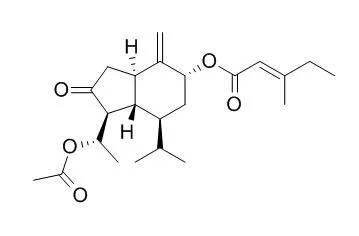| Kinase Assay: |
| Int Immunopharmacol. 2014 Oct;22(2):400-8. | | Tussilagone inhibits dendritic cell functions via induction of heme oxygenase-1.[Pubmed: 25091622] | Sesquiterpenoid Tussilagone (TUS) has a variety of pharmacological activities, such as anti-oxidant, anti-cancer, and anti-inflammatory activities.
METHODS AND RESULTS:
In this study, we investigated the effects of TUS on dendritic cell (DC) functions and the underlying mechanisms. TUS inhibited lipopolysaccharide (LPS)-induced activation of DCs, as shown by decrease in surface molecule expression, cytokine production, cell migration, and allo-T cell activation. In addition, TUS inhibited LPS-induced activation of NF-κB, MAPKs, and IRF-3 signalings in DCs, although it did not directly affect kinase activities of IRAK1/4, TAK1, and IKK, which suggests that TUS might indirectly inhibit TLR signaling in DCs. As a critical mechanism, we showed that TUS activated heme oxygenase-1 (HO-1), which degrades heme to immunosuppressive products, such as carbon monoxide and bilirubin. HO-1 inhibitor reversed the inhibitory activity of TUS in DCs.
CONCLUSIONS:
In conclusion, this study suggests that TUS inhibits DC function through the induction of HO-1. | | Int Immunopharmacol. 2009 Dec;9(13-14):1578-84. | | The anti-inflammatory effect of tussilagone, from Tussilago farfara, is mediated by the induction of heme oxygenase-1 in murine macrophages.[Pubmed: 19800419] | | Tussilagone (TSL), isolated from the flower of buds of Tussilago farfara (Compositae), is a sesquiterpenoid that is known to exert a variety of pharmacological activities. In the present study, we demonstrated that Tussilagone exerts anti-inflammatory activities in murine macrophages by inducing heme oxygenase-1 (HO-1) expression. Treatment of RAW264.7 cells with Tussilagone-induced HO-1 protein expression in a dose- and time-dependent manner without the induction of HO-1 mRNA expression. Tussilagone-mediated HO-1 protein induction was not inhibited by treatment with actinomycin D, a transcriptional inhibitor, but by cycloheximide, a translational inhibitor. Moreover, mitogen-activated protein kinases (MAPKs) inhibitors such as SB203580, SP600125, and U0126 did not block Tussilagone-mediated HO-1 protein expression, suggesting that the Tussilagone-mediated HO induction may be regulated at the translational level. Consistent with the notion that HO-1 has anti-inflammatory properties, Tussilagone inhibited the production of nitric oxide (NO), tumor necrosis factor (TNF)-alpha, and prostaglandin E2 (PGE2) as well as inducible nitric oxide synthase (iNOS) and cyclooxygenase-2 (COX-2) expression in lipopolysaccharide (LPS)-stimulated RAW264.7 cells and murine peritoneal macrophages. Inhibition of HO-1 activity by treatment with zinc protoporphyrin IX (ZnPP), a specific HO-1 inhibitor, abrogated the inhibitory effects of Tussilagone on the production of NO and PGE2 in LPS-stimulated RAW264.7 cells. Taken together, Tussilagone may be an effective HO-1 inducer that has anti-inflammatory effects, and a valuable compound for modulating inflammatory conditions. |
|






 Cell. 2018 Jan 11;172(1-2):249-261.e12. doi: 10.1016/j.cell.2017.12.019.IF=36.216(2019)
Cell. 2018 Jan 11;172(1-2):249-261.e12. doi: 10.1016/j.cell.2017.12.019.IF=36.216(2019) Cell Metab. 2020 Mar 3;31(3):534-548.e5. doi: 10.1016/j.cmet.2020.01.002.IF=22.415(2019)
Cell Metab. 2020 Mar 3;31(3):534-548.e5. doi: 10.1016/j.cmet.2020.01.002.IF=22.415(2019) Mol Cell. 2017 Nov 16;68(4):673-685.e6. doi: 10.1016/j.molcel.2017.10.022.IF=14.548(2019)
Mol Cell. 2017 Nov 16;68(4):673-685.e6. doi: 10.1016/j.molcel.2017.10.022.IF=14.548(2019)